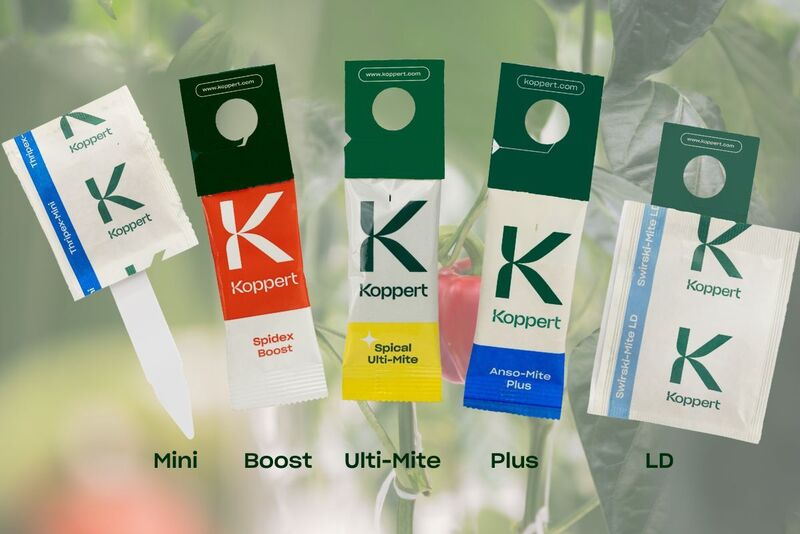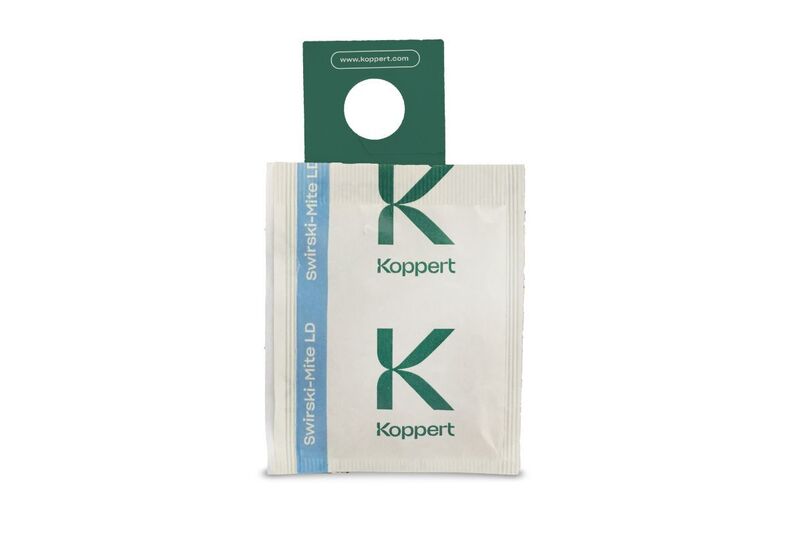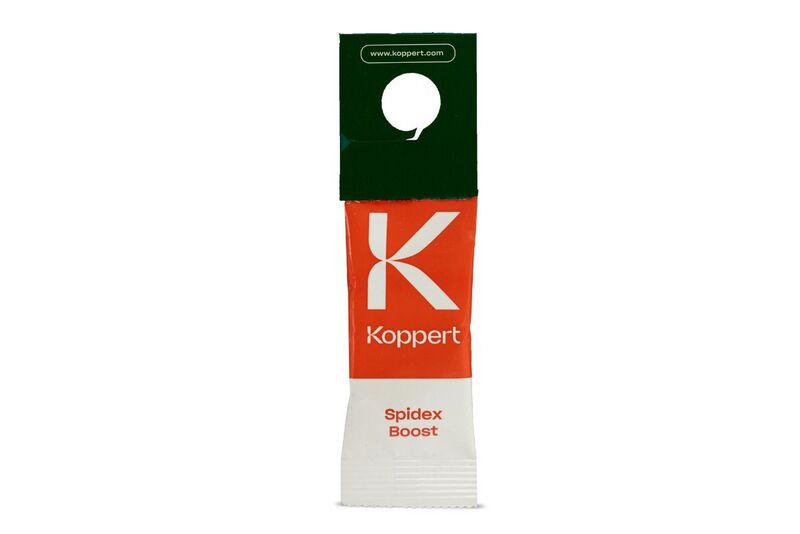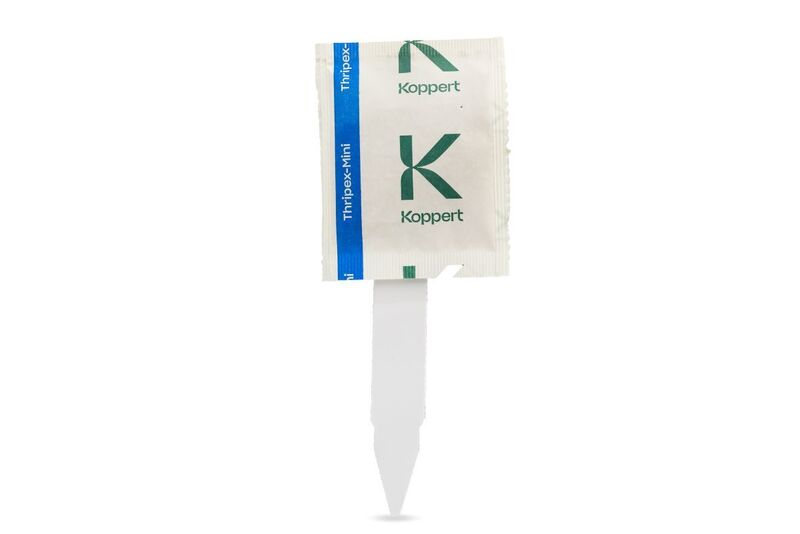The development of predatory mite breeding sachets has revolutionized bio-control in greenhouses, grow rooms and house plant settings, but failing to choose the best sachet formulation for your crop can put your harvest at risk. For example, choosing the wrong sachet for your environment can lead to premature expiration of your sachets leaving your crop exposed to pests such as thrips, spider mites, hemp russet mites, broad mites and whiteflies.
Koppert has many different predatory mite sachet options including:
- Ulti-Mite sachets
- Plus sachets
- Boost sachets
- Mini sachets
- LD sachets.
In order to understand which sachet is the best choice for you it is important to first understand what is in a sachet and how they work. Most will act as individualized breeding systems, slowly releasing all stages of predatory mites into a crop over a 4 to 10-week time period, depending on the sachet type and climate. The one sachet we produce that does not do this is our Boost sachets.

How do Breeding Sachets Work?
Each breeding sachet consists of:
- bran
- a select type of bran yeast
- one or more types of bran mites
- the predator mite
In this system, the yeast grows on the bran acting as a food source for the bran mites, which in turn acts as a food source for the predator mite. After feeding on the bran mites, the predator mites then breed inside the sachet, and slowly overtime (4-10wks), leave through the exit hole to patrol your crops for pests. In order for the sachet to continue producing to sustain this cycle of life, the humidity must be high enough for the yeast to continue to grow on the bran.

What is the difference between each type of sachet and which one is the best choice for your crop?
Ulti-Mite sachets are the best choice in:
- Low relative humidity conditions
- Situations where the sachet will be directly exposed to water (overhead watering, rain etc.)
- When you need protection from high air flow from circulation fans
Ulti-Mite sachets are made out of a climate resistant material that protects the breeding system inside from the type of environmental conditions explained above. Each Ulti-Mite sachet comes with one type of feeder mite and one type of predatory mite.
Main uses for Ulti-Mite sachets: cannabis, house plants, ornamentals with overhead watering, and outdoor vegetable gardens
Swirski Ulti-Mite | Control Thrips and Whitefly | Predatory Mites (Amblyseius swirskii)
Spical Ulti-Mite | Spider Mite Control | Predatory Mites (Neoseiulus californicus)

Plus sachets are best used in:
- High humidity conditions (i.e Greenhouses)
- Where the sachet will NOT be exposed to overhead watering
Each Plus sachet is made out of paper and contains one feeder mite and one type of predatory mite. The paper can easily be damaged by low humidity conditions, so it is best used in conditions with higher average relative humidity levels.
Main uses for Plus sachets: greenhouse vegetables and greenhouse ornamentals that are not overhead watered
Swirski-Mite Plus | Control Thrips and Whitefly | Predatory Mites (Amblyseius swirskii)
Thripex-Plus | Thrips Control | Predatory Mites (Neoseiulus cucumeris)
Anso-Mite Plus | Thrips Control | Predatory Mites (Amblyseius andersoni)
Spical-Plus | Spider Mite Control | Predatory Mites (Neoseiulus californicus)
Spidex Vital Plus | Spider Mite Control | Predatory Mites (Phytoseiulus persimilis)

LD sachets are best used in:
- High humidity conditions (i.e Greenhouses)
- Where the sachet will NOT be exposed to overhead watering
The LD sachets are our long lasting sachets due to the two types of feeder mites that come in the sachets. The extra feeder mite allows the sachet to last 60% longer than our other sachets and will produce 35% more predatory mites over this time. However, initially they will come with less predatory mites, so these sachets are not the greatest to use if you are already starting with pest pressure.
Main uses for LD sachets: greenhouse vegetables or greenhouse ornamental that are not overhead watered where a higher number of predatory mites over a longer period of time are required.
Swirski-Mite LD | Control Thrips and Whitefly | Predatory Mites (Amblyseius swirskii)

Boost sachets are best used in:
- Low relative humidity conditions
- Situations where the sachet will be directly exposed to water (overhead watering, rain etc.)
- When you need protection from high air flow from circulation fans
Boost sachets are made out of a climate resistant material that protects predatory mites inside from the type of environmental conditions explained above. Boost sachets are NOT a breeding system. They are only to be used for hot spot spider mite introductions. Must be applied weekly or bi-weekly onto the plants. Each sachet comes with 100 Phytoseiulus persimilis.
Main uses for Boost sachets: cannabis, house plants, ornamentals with overhead watering, outdoor vegetable gardens, direct hot spot infestations.
Spidex Boost | Control Spider Mite | Predatory Mites (Phytoseiulus persimilis)

Mini sachets are best used in:
- High humidity conditions (i.e Greenhouses)
- Where the sachet will NOT be exposed to overhead watering
Each Mini sachet is made out of paper and contains one feeder mite and one type of predatory mite. The paper can easily be damaged by low humidity conditions, so it is best used in conditions with higher average relative humidity levels. Only comes with our Neoseiulus cucumeris predatory mite. 100 predatory mites per sachet.
Main uses for Mini sachets: greenhouse vegetables and greenhouse ornamentals that are not overhead watered
Thripex Mini Sachets (Thrips Control) – Retail Koppert Canada
